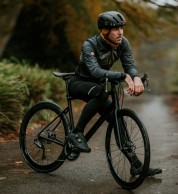Keys to consider to personalize your training
Personalized training focuses efforts on the objectives and specific conditions of each cyclist. Thus, organization, flexibility and rest are some of the most important aspects to successfully plan this type of training.

Personalized training, the importance of knowing how to organize yourself
Designing a training plan may be more or less straightforward for someone with a fixed schedule and free from family ties. But it can become a real headache for those who have rotating shifts or for those who are sometimes forced to postpone their outings because of family obligations. So how do you plan a training session in these cases?
First of all, we must know in detail when we are going to be able to ride a bike. We must try to detail the schedules as much as possible and consider what our priorities are. It is likely that we will have more free time on the weekend, but also that we will want to share it with our family.
RECOMENDADO

The best apps for cycling and mountain biking

Black Friday 2025 cycling bargains: save on Garmin, POC, Maxxis and more

Black Friday Garmin 2025: the ultimate guide to choosing your GPS at the best price

Which profile wheels to choose according to the area where you live: mountain, flat or coast

How to wash your cycling clothes? 10 keys to make them always look new

Cycling can help you fight the effects of the time switch
In this way, you can opt for a shorter and harder session on weekends and leave the longer outings for another time; one option could be before or after going to work, although it will depend on each case.
Secondly, we must be aware of what our training priorities are. That is, what results we hope to achieve. Obviously, someone interested in cyclocross will have to dedicate part of his or her time to exercising the skills of the discipline, while for a newcomer to cycling it will be enough to get into the routine of practicing it on a regular basis.
From here, it will be easy to place the priority training sessions in those slots where we have more time to do them. Thus the margin we have for possible setbacks will be larger in those sessions that we consider more important.

The great help of being honest and flexible
As much as we want to go out and train, there are many factors that sometimes prevent us from doing so. That's why it's good to be realistic from the start. If you have little time, it is better to focus your training for a week on fewer hours than to be overly optimistic and plan a training session that you will most likely not be able to complete.
As we have mentioned before, as far as possible we should leave a 'just in case' margin both before going out and once we have finished. This way, we can train without changing our plans in case we take a little while to start or have a flat tyre, for example.
When planning, you should generally avoid having a long ride before a high intensity training day.
And here comes another key player: flexibility. We must allow ourselves to vary the training plan when we have to do so. Delaying a training day is not a bad thing, although we must be careful not to accumulate several postponed days in the same session, as they will then lose quality.
On the other hand, we must keep in mind that we can still go out even if we only have 30 minutes to do so. It will be little, but it will be more than doing nothing.
Hence the importance of, despite planning the training, asking ourselves how much time we have available when the day arrives. Modifying the training will not be ideal, but being flexible in these cases will be important not to skip the whole exercise.
Rest, the great forgotten
Rest should certainly not be skimped on. Even if you really want to ride, rest brings many benefits and will help you to recover mentally and physically when you need it.
And finally, of course, nutrition also plays an important role. So the best thing to do is to organize ourselves in such a way that we can eat properly before, during and after training.